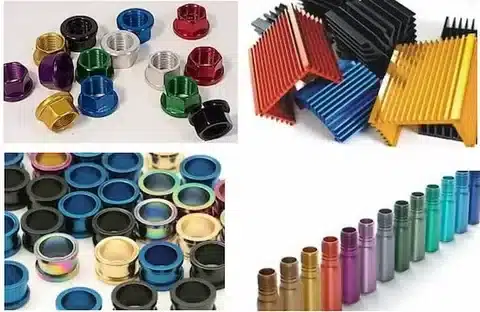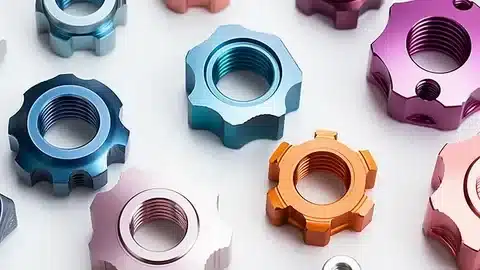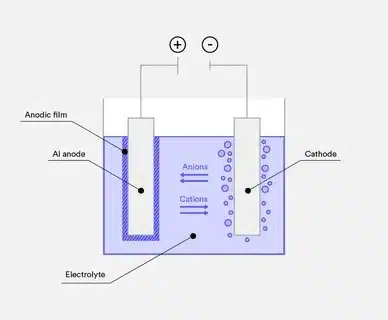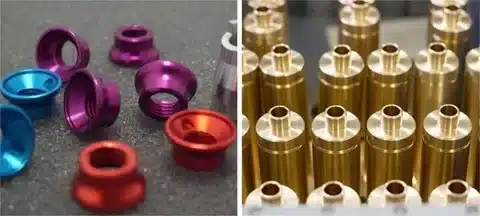Find out the main differences between hard anodizing and regular anodizing. Find out about strength, looks, prices, and applications to make the best decision in your aluminum projects.
Introduction: Why the Anodizing Process Matters

Not every anodizing is created equal in the case of an aluminum finish. Be it in the designing of aerospace parts or kitchen cookware, the differences between hard and regular anodizing can make or break the performance of your product. The selection of these two processes influences such issues as durability and cost, aesthetics, and functionality.
Anodizing is one of the best electrochemical processes for altering the surface of aluminum in order to enhance the natural characteristics of the metal. This treatment not only increases the corrosion resistance but also enhances the wear properties and allows aesthetic personalization. But the choice of regular or hard anodizing needs to be weighed against your individual needs of application, the environment, and performance potential.
This detailed guide will define the differences between hard and regular anodizing, and it will give you the technical expertise to make a sound decision that will not only enhance performance but also cost-effectiveness to your aluminum projects.
What Is Anodizing?

Anodizing is an electrolytic passivation whereby the natural oxide layer on the surface of aluminum is enhanced in thickness, which significantly enhances the corrosion and wear resistance of the metal. Contrary to the processes which are used for coating, in anodizing, the existing aluminum is transformed to aluminum oxide through controlled oxidation.
The process of anodizing is conducted by placing the aluminum components in an electrolytic solution, mostly sulfuric acid, and a direct current is applied. This electrochemical cell has aluminum as the anode, and this results in the mixture of oxygen ions and the aluminum atoms on the surface. The reaction gives a porous aluminum oxide coating, which can be covered to improve its protective ability. The resulting oxide coating is also part of the aluminum, so the issue of coating adhesion or delamination is forgotten.
Characteristics of the final oxide layer are determined by process parameters such as voltage, temperature, time, and electrolyte concentration. Anodizing is a very flexible method of surface treatment because one can vary these variables to obtain certain thickness, hardness, and appearance requirements.
Hard Anodizing vs. Regular Anodizing: A Comparative Analysis

Oxide Layer Thickness
The absolute distinction between regular and hard anodizing is the thickness of the oxide layer obtained with each process. Type II anodizing, which is regularly anodized, forms a fairly thin oxide coating usually between 0.0002 and 0.0006 inches (5 to 15 microns) thick. This degree of thickness offers sufficient protection to the majority of decorative and light-duty missions and allows dimensional stability.
Hard anodizing, known as Type III anodizing, forms a much heavier oxide coating of 0.0005 to more than 0.003 (12 to 75+ microns). This added thickness should be noted in the design stages because the oxide layer is increasing in thickness, both inwards and outwards of the initial aluminum surface, which may impact the criterion dimensions and tolerances.
Hardness and Durability
Frequent anodizing offers medium hardness on the surface with decorative and low-load applications. Oxide coating is a good abrasion-resistant surface for consumer items, though it might not be able to handle extreme mechanical loading or contact with hard substances.
Hard anodizing can obtain a very high level of surface hardness, commonly above 400 HV (Vickers Hardness), close to that of tool steels. Such an outstanding hardness results in hard anodized surfaces that are highly wear-resistant, scratch-resistant, and mechanical damage-resistant. Hard anodizing is superior for use in applications that require sliding contact, aggressive environments, or contact with abrasive materials due to its high level of durability.
Corrosion Resistance
The anodizing processes have great enhancements on the natural corrosion resistance of aluminum, though to varying degrees. Anodizing done regularly has great protection against corrosion occurring in the atmosphere and can be used in indoor or light outdoor conditions. Most common applications have sufficient protection of their barriers provided by the thinner oxide layer.
Hard anodizing provides better corrosion protection because of its denser and thicker oxide layer. Having such a high protection level allows hard anodized components to be used in heavy environments, such as marine, chemical equipment processing, and outdoor installations that are subjected to extreme weather conditions. The higher thickness comes with the added advantage of multiple layers of protection, which guarantee a long-term operation despite slight damage on the outer surface.
Appearance and Aesthetics
Aodizing provides an outstanding aesthetic versatility with numerous colors available by means of dyeing. The porous nature of the oxide layer easily incorporates dyes so that it can take in bright colors but still retain the natural metallic luster in aluminum. Bright and reflective finishes can be reached on the surface and are very attractive to the architecture and consumer uses.
Hard anodizing usually gives an appearance that is more matte and darker, usually dark gray to black. Dyeing is more difficult because the oxide is in a very thick structure, reducing the variety of colors that can be used. Although this can be considered a disadvantage, the unique look of the hard anodizing is usually wanted in industrial applications when a professional, utilitarian look is required.
Cost and Application Suitability
Frequent anodizing is a less expensive alternative because of reduced processing time, less power, and fewer equipment needs. It is an appropriate process where the production of consumer goods, decorations is needed, and where moderate protection is needed in high volumes.
The hard anodizing is more expensive because of the longer processing time, high-energy consumption, and strenuous process control specifications. The extra cost is reasonable in case of applications that need higher durability, wear resistance, or corrosion resistance. Industries like aerospace, defense, and precision machinery tend to require hard anodizing even at the increased cost in favor of its performance.
Applications: Choosing the Right Process for Your Needs

Regular anodizing is ideal in cases where the aesthetics, economic considerations, and moderate protection are the key factors. Typical uses are building panels, consumer electronics cases, decorative strips, light housing, and furniture components. Regular anodizing is the best choice due to the capability of attaining different colors and finishes, thus suitability in the products where visual appeal is important.
Hard anodizing is the ideal one that is used in demanding applications that involve maximum protection and durability. The hard anodizing of aerospace parts, hydraulic cylinders, auto engine parts, precision machine components, and industrial tooling is enhanced by the good wear and corrosion resistance properties of hard anodizing. Hard anodizing is also an aspect that is common aspect in medical device parts and semiconductor manufacturing equipment due to its biocompatibility and chemical resistance.
Visual Comparison: Hard vs. Regular Anodizing
| Characteristic | Regular Anodizing (Type II) | Hard Anodizing (Type III) |
| Oxide Thickness | 0.0002″ – 0.0006″ (5-15 μm) | 0.0005″ – 0.003″+ (12-75+ μm) |
| Surface Hardness | 200-300 HV | 400+ HV |
| Corrosion Resistance | Good – Indoor/mild outdoor | Excellent – Harsh environments |
| Appearance | Bright, colorful, reflective | Matte, dark gray/black |
| Cost | Lower | Higher |
| Processing Time | Shorter | Longer |
| Color Options | Wide range available | Limited (grays/blacks) |
| Typical Applications | Consumer goods, architectural | Aerospace, industrial machinery |
FAQs: Common Questions About Anodizing

Can anodized aluminum be dyed? Yes, anodizing is easy to stain with dyes since it has a porous oxide structure, permitting vivid color and bespoke looks. Hard anodizing cannot be dyed so easily because the oxide layer is dense, but using special dyeing methods, some coloration is possible.
Is hard-anodized cookware safe to use? Absolutely. Hardened anodized cookware is totally safe in food preparation. The aluminum oxide surface is inert, non-toxic, and will not come into food. This hard anodized surface is also very heat-distributive and durable, which can be used in cooking.
Can I anodize aluminum at home? Though it can technically be done, anodizing also needs specialized equipment, controlled chemical baths, and good safety measures. Home anodizing generally yields lower-quality results than professional processing and is very dangerous because of the acids and electricity used.
Conclusion: Making the Right Choice
The decision of using regular anodizing or hard anodizing finally rests on the performance needs, the beauty, and the economic requirements of your application. Anodizing and regular Anodizing are great in both decorative and moderate duty operation, offering good protection at better aesthetic versatility at reduced cost. Hard anodizing warrants its increased cost by its superior durability, wear resistance, and corrosion resistance, warranting its essential use in challenging industrial, aerospace, and precision work. Through a careful consideration of the environmental conditions of your project, mechanical requirements of your project, the appearance specifications of your project, and budget constraints of your project, you can identify the anodizing process that provides the best long-term performance and value to your aluminum parts.

